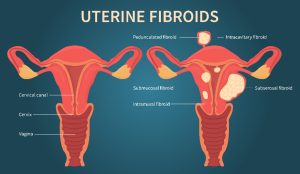
Uterine fibroids are tumors made of smooth muscle and connective tissue. They are benign, but contain more estrogen and progesterone receptors than most uterine muscle cells. Estrogen and progesterone are well-known hormones that stimulate the development of the uterine lining during the menstrual cycle. They are useful and even essential to the body.
However, their imbalance can cause abnormal growths in the uterus whenever their levels increase unnecessarily. As a result, seventy to eighty percent of women are prone to fibroid growth. However, many of them do not seek treatment even though fibroids can cause infertility and profuse bleeding that sometimes leads to anemia. Submucosal fibroids can affect fertility not by interfering with ovulation, but by simply hindering the uterus from maintaining pregnancies, which is significant enough to be a cause for concern among women that wish to procreate.
As a tumor, the uterine fibroid multiplies rapidly when exposed to the aforementioned hormones. Therefore, it is wise to avoid foods that can increase estrogen levels. Among such specific foods are sweets and refined carbohydrates (pasta, white bread, white rice, cakes and cookies).
Risk Factors
Risk factors for the growth of uterine fibroids include: old age, menopause, large consumption of red meat, obesity, vitamin D deficiency, alcohol consumption, stress and a diet low on fruit, vegetable or dairy. In terms of stress as a risk factor, it is important to understand that stress is a biochemical response to effort, challenges and difficult circumstances. Stress is handled by the body through the production of extra hormones. Therefore, it can lead to a rise in hormone levels that can stimulate fibroid growth and flare-ups. Furthermore, under the influence of stress, pre-existing fibroids can become symptomatic and release red, pinkish or brown discharge.
Reduction of Risk
According to doctors providing uterine fibroid embolization in Arizona, reduction of risk can be achieved by: lowering blood pressure, supplementing with vitamin D, giving up smoking, balancing estrogen levels, relinquishing alcohol drinking and enjoying a Mediterranean diet that includes fresh fruit, vegetables and fish. Avoiding certain foods can also be part of the process if one can give up: caffeine, hyper-caloric sweets, high-fat meat, sugary drinks, salt and added sugar. Conversely, nutrition support consists of: fiber-rich foods (including oats and barely), potassium-rich fruits and vegetables (such as bananas and avocados) and calcium-rich products such as dairy.
Prevention can also play an important role in living a fibroid-free life, which is why supplementing with vitamins A and B-1 can be very useful. The former can be ingested from animal sources –usually dairy products –and the latter can be administered by means of injections or medication that also helps with bloating, cramping and menstrual pain.
Treatment Options
Medical treatment is usually required to reduce the symptoms and effects of uterine fibroids. Among the best options, myomectomy is a procedure used to remove fibroids in a mild and safe manner. It is highly effective and less invasive than hysterectomy which consists of removal of the entire uterus. However, fibroid tissue can also be passed during one’s period naturally or after being treated with UFE (uterine fibroid embolization).